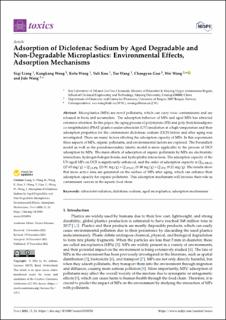| dc.contributor.author | Liang, Siqi | |
| dc.contributor.author | Wang, Kangkang | |
| dc.contributor.author | Wang, Kefu | |
| dc.contributor.author | Kou, Yuli | |
| dc.contributor.author | Wang, Tao | |
| dc.contributor.author | Guo, Changyan | |
| dc.contributor.author | Wang, Wei | |
| dc.contributor.author | Wang, Jide | |
| dc.date.accessioned | 2023-01-04T10:51:38Z | |
| dc.date.available | 2023-01-04T10:51:38Z | |
| dc.date.created | 2023-01-02T16:01:01Z | |
| dc.date.issued | 2023 | |
| dc.identifier.issn | 2305-6304 | |
| dc.identifier.uri | https://hdl.handle.net/11250/3040873 | |
| dc.description.abstract | Microplastics (MPs) are novel pollutants, which can carry toxic contaminants and are released in biota and accumulate. The adsorption behavior of MPs and aged MPs has attracted extensive attention. In this paper, the aging process of polystyrene (PS) and poly (butyleneadipate-co-terephthalate) (PBAT) plastics under ultraviolet (UV) irradiation at a high temperature and their adsorption properties for the contaminant diclofenac sodium (DCF) before and after aging was investigated. There are many factors affecting the adsorption capacity of MPs. In this experiment, three aspects of MPs, organic pollutants, and environmental factors are explored. The Freundlich model as well as the pseudosecondary kinetic model is more applicable to the process of DCF adsorption by MPs. The main effects of adsorption of organic pollutants by MPs are electrostatic interactions, hydrogen-halogen bonds, and hydrophobic interactions. The adsorption capacity of the UV-aged MPs on DCF is significantly enhanced, and the order of adsorption capacity is Q(A-PBAT) (27.65 mg/g) > Q (A-PS) (23.91 mg/g) > Q (PBAT) (9.30 mg/g) > Q (PS) (9.21 mg/g). The results show that more active sites are generated on the surface of MPs after aging, which can enhance their adsorption capacity for organic pollutants. This adsorption mechanism will increase their role as contaminant carriers in the aquatic food chain. | en_US |
| dc.language.iso | eng | en_US |
| dc.publisher | MDPI | en_US |
| dc.rights | Navngivelse 4.0 Internasjonal | * |
| dc.rights.uri | http://creativecommons.org/licenses/by/4.0/deed.no | * |
| dc.title | Adsorption of Diclofenac Sodium by Aged Degradable and Non-Degradable Microplastics: Environmental Effects, Adsorption Mechanisms | en_US |
| dc.type | Journal article | en_US |
| dc.type | Peer reviewed | en_US |
| dc.description.version | publishedVersion | en_US |
| dc.rights.holder | Copyright 2022 the authors | en_US |
| dc.source.articlenumber | 24 | en_US |
| cristin.ispublished | true | |
| cristin.fulltext | original | |
| cristin.qualitycode | 1 | |
| dc.identifier.doi | 10.3390/ toxics11010024 | |
| dc.identifier.cristin | 2099040 | |
| dc.source.journal | Toxics | en_US |
| dc.identifier.citation | Toxics. 2023, 11 (1), 24. | en_US |
| dc.source.volume | 11 | en_US |
| dc.source.issue | 1 | en_US |

